By ROB FELD
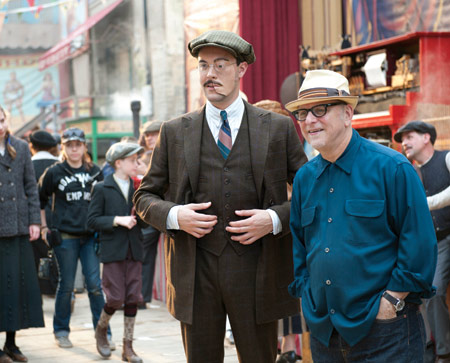
Allen Coulter’s goal is to find the emotional core of a scene, as he works with Jack Huston.
It’s 1924, the dawn of the jazz age, with all the transgressive excitement and bootlegging danger the era conjures—at least that’s the fantasy easily indulged standing amidst the costumed cast on the infinitely detailed Boardwalk Empire sets at Steiner Studios in Brooklyn. Director and executive producer Tim Van Patten enters this bygone world, just returned after 19 hours overseeing a location night shoot in Staten Island.
He will soon head upstairs to his office to prep for the season finale, an episode he has directed himself in each of the show’s four seasons, but first he pops onto the set where Allen Coulter is directing Steve Buscemi in the season’s penultimate episode. Buscemi sits alone in a corner of the Albatross Hotel set, warmly lit by a desk lamp, but isolated in an earth-toned long shot reminiscent of an Edward Hopper composition.
“If you have an episode that deals with the isolation of a character, you might want to refer to Hopper,” says Van Patten of one of the show’s frequent stylistic references. “If you look closely at the subject of a Hopper painting, you won’t get as much information about the character as you would if you back up and see where that character is in context of the frame itself. You will get an emotion just from the composition. We think a great deal about these things. The director is allowed to bring his own ideas to the table and I would say that if there’s a rule it’s just to keep it organic, so it doesn’t feel like you are trying to be stylish.”
The great majority of Boardwalk Empire’s episodes have been helmed by HBO regulars Van Patten, Coulter, Ed Bianchi, and Jeremy Podeswa, all with great autonomy, but with Van Patten serving as conductive glue between them and the writers’ room. While prepping multiple episodes of his own, he is with them on location scouts and casting, and serves as a general sounding board for ideas which might radically alter a script as it’s written. Coulter is an old hand and deep into his episode, so today’s conversation is more collegial, focusing on a challenge Van Patten is facing himself: shooting an interior night shot with no apparent source light.
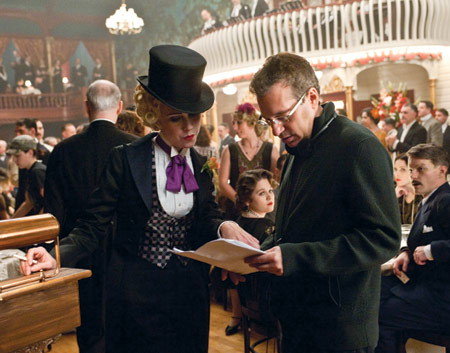 NIGHTLIFE: Jeremy Podeswa, with Tracy Lynn Middendorf, says the style of the show has become more expansive.
NIGHTLIFE: Jeremy Podeswa, with Tracy Lynn Middendorf, says the style of the show has become more expansive. The one thing these directors share is a sense of ownership and investment in their episodes, which they say is rare in television. Preproduction tone meetings follow the style David Chase established on The Sopranos where the director takes the writer through an episode. And throughout production there is an open door policy to showrunner Terrence Winter and the writers’ room on Steiner’s third floor. The directors collect and share information in a way that welcomes their contributions to script interpretation, all with the goal of enhancing the greater mission of the series, episode to episode.
Van Patten’s Emmy-nominated third season finale, for example, begins with an extended, unscripted montage of gangster hits he felt the episode needed. He pitched the idea to Winter, but grabbed the shots on the fly, unscripted.
“I didn’t see the full thing until I saw his edited cut,” says Winter, “and what I saw in his director’s cut is what went on TV.” To a great extent, the trust given to these directors is the result of Van Patten’s long and close relationship with Winter, the show’s creator, which dates back to their frequent collaboration and creative synchronicity on The Sopranos.
“As soon as I knew there was going to be a show, the first person I begged to be part of it was Tim,” recalls Winter. “I wanted to work with him as much as possible, and to have him direct as much as possible, so the best way was to integrate him into the show completely. He functions as part of the writing staff as well, so there isn’t any aspect in which he’s not directly involved.”
Boardwalk chronicles the doings of corrupt city treasurer-cum-bootlegging kingpin Enoch “Nucky” Thompson (Buscemi) during Prohibition-era Atlantic City. The gangster and flapper studded worlds of the boardwalk, speakeasies, clubs, mansions and rural shacks, from New York to D.C. to Chicago, were first presented in a pilot episode directed by Martin Scorsese (for which he won a DGA Award for Outstanding Dramatic Series), with a reported budget of $20 million-$30 million. HBO does not lavish such amounts on every episode, but no need seems to go unmet, and the production values are certainly evident on the set today, as Coulter moves from room to lavishly decorated room and surveys the Albatross Hotel patio, which is doubled on a standing set on the shore of Far Rockaway, Queens. There it can overlook the Atlantic Ocean instead of the backdrop at Steiner.
Coulter calls action on a series of setups that will show Nucky talking in profile on the phone, working slowly toward speaking a hard truth about himself. Thematically, the episode is about lies, and with each cut and conversational exchange, Coulter and director of photography David Franco push in and pivot the camera around Buscemi, until he is full faced—literally and metaphorically facing his truth. Between takes Coulter consults with Buscemi, agreeing that the phone conversation is in essence between Nucky and himself, the woman on the other line simply a happenstance. It’s the final scene of the episode but designed to visually and thematically echo one from the beginning.
For Bianchi, collaborating closely with series actors on their process and knowledge of their characters is critical to making a scene work. In a season four episode, Bianchi went to Michael Shannon, who plays G-man-turned-con Nelson Van Alden, with a specific moment he needed to show that his character is thinking of changing allegiances. “He thought about it and came back to me 10 minutes later and said, ‘I can give you that when I stop here and walk away.’ So I changed the shot I’d planned because that’s where he felt he could give it to me.”
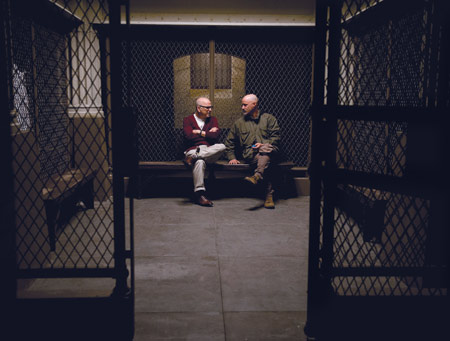
MOVIE JAIL: (above) Coulter (left) and Van Patten talk it over from inside a prison cell. (below) Bianchi, with kingpin Steve Buscemi, likes to collaborate with the actors on their process to make a scene work.
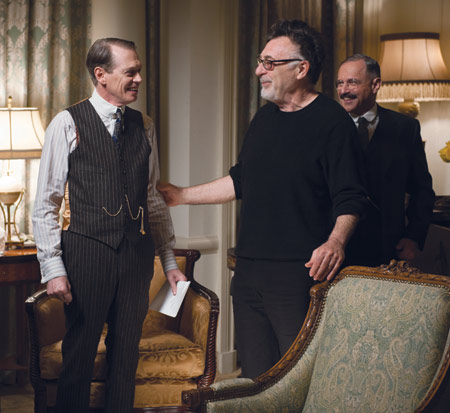
“We try not to be arbitrary,” explains Van Patten. “You keep jumping out of bed in the morning and coming here because you know you’re free to express. As Allen always says, ‘Identify the emotional core of the episode and the rest will follow.’ It really unlocks the door. I apply that notion to everything. It will help you frame a shot.”
The series began auspiciously and ambitiously for future directors with the Scorsese pilot. Van Patten then helmed the next two episodes, which granted him a long run of working with the actors, and gave the directors to follow three hours to refer to, rather than just two from different directors.
“Marty was very much a part of the process of setting the tone,” says Van Patten, who recalls sitting with Winter as Scorsese screened film after film from his private collection to provide references for his episode and those to come. “Sam Fuller’s Park Row, Pete Kelly’s Blues, Al Capone with Rod Steiger, Roger Corman’s The St. Valentine’s Day Massacre, Raoul Walsh’s The Roaring Twenties, William Wellman’s The Public Enemy, Elia Kazan’s Splendor in the Grass,” lists Van Patten. “Sometimes he would offer commentary throughout the whole film. Then we would watch films to inform the smallest details, like Vincente Minnelli’s Some Came Running, just for the carnival scene, to get what the honky-tonk nightlife in Atlantic City looked and felt like. We’d watch a whole film just to see a bootlegger’s still that was in the movie. It’s your dream come true, obviously, Martin Scorsese giving us a lesson in film history.”
Van Patten’s office walls are a collage of referential clippings that grew from early conversations about the show’s aesthetic; his coffee table is merely a platform for similarly purposed art books. “We engaged several DPs we knew,” continues Van Patten, “Jonathan Freeman and Kramer Morgenthau, and over the years David Franco and William Coleman. We arrived at a palette which largely included the work of the Ashcan artists—George Bellows, George Luks, William Glackens, Everett Shinn, John Sloan, and their contemporary, Edward Hopper,” he says of the clippings.
“Very often you’ll see one of those images pop up in the show,” says Winter, referring to Van Patten’s cluttered wall. “There’s one with a detective standing over a dead body in a marsh somewhere. We don’t even know where it’s from, but that shot found its way into an opening montage.”
Episodes are shot in 12-14 days. The final days overlap the next director’s production, utilizing what they refer to as “simul-units,” with two assistant directors and two DPs rotating odd and even shoots. The directors rely on the ADs, Julie Bloom and Jude Gorjanc, to get them up to speed during prep, fill in information they may have missed, and help direct large crowd scenes.
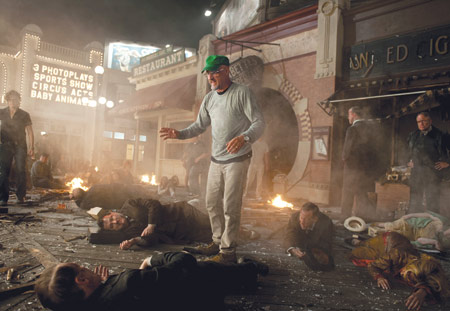
BLOW UP: Director-producer Tim Van Patten, who handles many of the shows’ set pieces, stages a dramatic scene in season three in which a boardwalk nightclub is bombed. “On this show, you jump out of bed in the morning to come in because you’re free to create.”
While Boardwalk’s directors revel in the creative freedom they have from episode to episode, a recognizable grammar did emerge from the initial Scorsese and Van Patten shows, which has guided the camerawork since. The series is shot on honest-to-goodness Kodak film stock (VISION3 5219, 5213 and 5207, to be precise), predominantly from low angles, with artfully composed frames and a fluid, moving camera, always motivated by the movement of the scene. There are few insert or establishing shots. “I never saw the story in them,” says Van Patten. “We try to achieve shots that offer story and throw you in it.”
The camera may push in, but you’d also be hard pressed to find a zoom, or a lens that doesn’t fall into the 21-65 mm range, which, it was agreed, more closely approximates a realistic image. Time is also allowed for shots to be carefully crafted, so television production shortcuts like slapping a long lens onto a second camera and shooting from two different perspectives simultaneously, in order to get a close-up from an off angle, are discouraged.
“Everybody has a different opinion about this, but I think these wider lenses give you a greater sense of intimacy,” says Coulter. “The longer the lens, the more the eye is aware of the physical distance from the character and, at least unconsciously, aware of the lens. The result is that the world in which the story takes place recedes and, along with it, some of the reality and mood of the story. Over time, [DP] Freeman, along with Van Patten, continued to develop the look of the series—figuring out how to light it and shoot it to make it even more shadowed and noirish.”
While there’s no hard and fast rule to keep the camera low, aside from occasionally aggrandizing the characters, there are practical reasons that go hand-in-hand with the wider lenses.
“It sounds odd,” says Van Patten, “but part of it is that in the 1920s there were great ceilings and we are a location-driven show. Even in the grander sense, they were coffered, magnificently built structures. I would say of a 14-day schedule we are probably out eight. When you find these gems in New York’s five boroughs, you tend to say, ‘Let’s see it all.’ But I try not to think of it as period when I shoot; people are people throughout history, nobody changes.”
“You get a greater sense of the place and a stronger dynamic,” says Coulter of shooting from below. “When you come up to eye level, everything flattens out and you don’t have the vanishing points as dramatically vivid as you do when you go a little bit lower. It allows more of an impact in those moments when you do come up to eye level.” Coulter, who frequently shoots through doorways, windows and other frames within the production design, says “in the best of all possible worlds you are constantly seeing things from a perspective that is unexpected, keeping it fresh.”
With four seasons under its creative belt, Boardwalk Empire has developed some signature moves. The directors often evoke suspense in the opening shot of an episode with the slow revelation of information. For example, in the opening of Coulter’s season three episode “Sunday Best,” neighborhood morning details lead suggestively into the story.
“You first hear morning doves,” describes Coulter. “Then you see a collection of shots of early morning light, creating an air of mystery— the solution to which is delayed. Then you hear rattling bottles before you see the milkman, which always intrigues me. In all these things, the viewer is constantly lagging slightly behind us before we reveal. A man emerges from a house, but the camera refuses to tilt up and reveal who it is. [He] bends down into the shot and puts something under a bush, and you think he might be hiding a gun. The camera follows him and delays a little dolly-in until he lifts a flowerpot; even his hand covers what it is until the last second when we see it’s an Easter egg, and it’s all been a big shaggy dog story and we now know it’s Easter Sunday.”
Van Patten is a master of the show’s crescendos, handling many of the big set pieces and more significant gangster hits. Many times he breaks convention and brings his camera up and directly over a character at the moment of his killing, or other diminution, as he did significantly in season three to gangster Gyp Rosetti (Bobby Cannavale), tracking above him as he ran naked and bloody through a maze of hallways. He later gives Gyp the same treatment as his flunky stabs him on the beach.
“It makes them small,” says Van Patten. “It’s essential to see the violence through a particular character’s eyes, to make it experiential. You are with Gyp when someone takes a hit on him.”
Bianchi, for his part, likes to keep his camera as invisible as possible, but not without contextual creativity, for instance when finding a solution to actress Kelly Macdonald’s real-life pregnancy last year.
“She was walking around in a cluttered room,” he recalls, “complaining to the kids. There was luggage all over, and food carts and everything, and their dog running around barking. I shot it from the dog’s point of view: low on the floor, so I wouldn’t see Kelly’s belly. It was an unusual place to go to solve the scene, but it worked perfectly; I cut from the floor to her face. I went to art school and worked as an art director in an ad agency, so I’m keen on the visual, but if the camera is going to get in the way of the story, you throw it out. But if I can make it smooth so you’re not realizing where I’m taking you, that’s good for me.”
Bianchi continues: “I look for the most adventitious place to put the camera that will get most of what I need in as few shots as possible. There is a scene in the episode I’m working on now where a character finds an empty bottle of whiskey, indicating that someone is drinking again, and she puts it on the table. So I chose to put the camera behind the table, let her enter and place the bottle in front of camera. To me that’s what the scene started out about, so I positioned the camera accordingly. I try to find something like that to lead me in every scene.”
For the opening of his season three episode, “Bone for Tuna,” Podeswa faced the challenge of integrating a surreal dream sequence Nucky has into a show that largely prizes verisimilitude.
“I love being handed things like that because they’re unusual for the show, but not without precedent,” he says. “For that one I wanted to echo a sequence in a previous season where Nucky dreams there is a dying deer in his office. It felt like this scene wanted to live in a world similar to that earlier manifestation of altered consciousness. It still had the hallmarks of the show—the low angles, the wide angle—but it offered an opportunity to maybe push things a little bit more because it’s a dream sequence. I didn’t want the audience to knowthat they were watching a dream at first.
“It felt like the show, to start,” adds Podeswa, “then little clues came that things were off. It was written that way, but the visualization was interesting to conceive. I storyboarded the sequence and tried to map out when you realize something’s off. Playing with sound design became a big element as well, using many sounds that were not organic to the location. Even though the show is rooted in the real world, it has a degree of stylization that allows for these kinds of flights of surrealism. I think they work really well, particularly because they’re anchored in Nucky’s mind. We are so with Buscemi and his character, that an opportunity to get inside his head, to get a sense of what he’s feeling and going through without getting on point with dialogue and exposition is great. To me that is pure cinematic storytelling.”
Almost any exterior scene in the show is a challenge since dressing a 360-degree view of a live location is a near impossibility when shooting period. But location scouting is a director’s first job once handed the script or outline for his episode, and the production makes great use of the variety offered by New York City’s surrounds.
“You’re looking at new locations for every episode, and you try to find ones that are versatile but that can also work in the specific ways that you need them to, to serve your plan for visualizing the scene,” says Podeswa. “Because it’s a period show, you really have to know what angles you are going to use, what you need to build, what you need to change, and what visual effects can fix. You also have to think about the limitations of the art department because, although it seems like they can do virtually anything, you do have to be mindful that maybe they can’t fully dress 20 new sets for every episode.”
When the need arises, however, a hefty dose of visual effects are also at their disposal. The original boardwalk set, in Greenpoint, Brooklyn, for example, is no more, and the new, shorter one is frequently augmented digitally.
“But you always want to connect a living, breathing world with our fantasy world,” reminds Van Patten. “Sometimes we needed to shoot at the actual ocean, and connect it to the boardwalk through visual effects. That goes a long way to getting the audience on board. You really only need to do that a handful of times in a year and I feel like you own the audience, in terms of believability.”
From season to season, the show has a great deal of water to carry and track in terms of characters, story lines and locations. In this regard, Coulter explains how he handled an episode with Van Alden, who disappears suddenly, not to return until the next season. To properly mark his exit in the minds of the audience, the director had a hallway built for him to lumber through in a dramatic escape into whiteout daylight.
“By the time I shot my first episode this season there were many new sets that had been established by other directors,” says Podeswa, “so I wanted to see how they shot them and how they used the space. Sometimes it’s good to know just how the audience perceives a location when you want to signal that they’re in the same place again—maybe a familiar angle. It’s always been interesting for me to watch what other directors and DPs are doing on the show, and see how they expand its vernacular. The style has become more expansive over the seasons; people try different things. I think within a season you can see episodes that feel significantly different, depending on who’s directing and who the DP is.”
Van Patten’s message to the other directors, both veterans and newcomers to the show, is to push its boundaries: “It’s your movie. Be bold.” His own reference points range from Michael Cimino’s The Deer Hunter and the films of Peter Weir—for their economy and the specificity with which they present their moments—to Arthur Penn, Sam Fuller, and Sam Peckinpah, for their shootout montages.
“I think we arrived at a film language that worked,” concludes Van Patten. “We have roughly the same amount of scenes per episode, with one or two set pieces. But two of the great challenges are to fit in all the story elements without making it feel incredibly plot-driven, and to maintain a certain level of visual storytelling. And that’s what all these directors are good at. As seasons go on, naturally there’s more plot. So finding those moments where you can accomplish in one shot what might normally be done in three pages is the challenge. And then the ultimate challenge is connecting all the dots at the end of the season,” he says, returning to his third floor office to tackle just that.